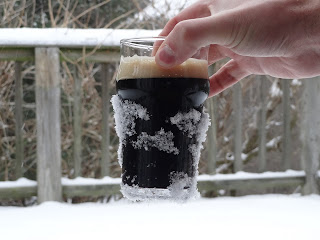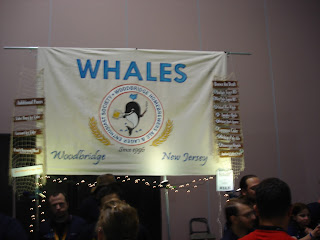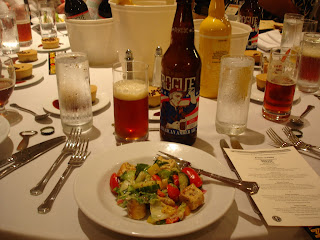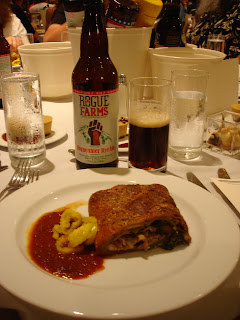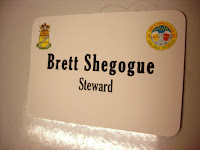In my 3+ year homebrew journey I have entered about 10 competitions. After about 2 years in the hobby, I knew I wanted to become a beer judge. I had heard from people on the forums getting into one of the Beer Judge Certification Program (BJCP) tests required a very proactive approach, and a long wait - they were right. I first inquired last April (2013) to see if I could take the BJCP exam in Frederick, MD in February of 2013. I was told that I could be placed 12th on the waitilist...wow! Didn't look like I was going to be able to take the exam on that day. I was then informed there would be another test in September of 2013 and did I want to be placed on the list to take it - YES! Knowing I had a seat in the exam, I procrastinated studying til last month - right inside of 6 months. I have been studying styles, their guidelines, and the brewing process on paper, but not as much hands-on, or should I say mouth-in, as I should be. Cue the 21st annual Spirit of Free Beer Competition.

The Spirit of Free Beer competition is put on by he D.C. area homebrew group, BURP (Brewers United for Real Potables) around the beginning of May every year. This year was the 21st installment of the competition, the third time I have entered, and the 1st time I have assisted as a steward. This competition is 1 of 16 qualifiers for the
Master Championship of Amateuer Brewers and pulls in some very qualified judges.
The competition was hosted by
Mad Fox Brewing Company and I arrived bright and early to get complimentary breakfast - caramel glazed donuts topped with bacon, and a fresh fruit tray was a great way to start the morning. I then proceeded to sign in and talk to some fellow brewing enthusiasts. A little after 8 the stewards were called and given preparatory information on how to assist the judges as well as the do's and don'ts. A steward's job is to is make sure the judge's have all the necessary materials which consist of beers, cups, water, and bread, as well as to manage the scoresheets after each beer is evaluated. Most judges will also allow the steward to get a sample of each entry to taste alongside the judges.
At 9am I was assigned to one of the 5 flights of
Category 14 - IPA. The first beer in our flight was definitely the best. Although there were no horrible beers, each consecutive entry tended to have a few stylistic flaws. Most common for our flight was a rather minimal hop character where beers tendy more to the malty side. We had all American IPAs and these beers need to be hoppy to score well! I was able to pick up some tricks for sensory evaluation of aromas. After pouring a sample, hold your hand over glass for a few seconds, after which, immediately take in a deep sniff. After sampling and filling out the scoresheets, the judges would share their scores and have a discussion about the beer. For the most part, in this category, my judges scores were within 3 points of each other so no changes needed to be made. Due to the number of flights, 1 to 2 beers from each flight was promoted to a mini best of show round. I watched as 5 judges (one from each flight to avoid bias) debated over 10 IPAs to deem 1st, 2nd and 3rd places in the category.
After all the mini BOS rounds were conducted it was time to break for lunch. Mad Fox provided us with a keg of their Defender American Pale Ale (very tasty!) to wash down our pork bbq sandwhiches, pasta salad, cole slaw, and fresh mixed green salad. Our sweet tooths were also indulged in the form of chocolate chip cookies, and brownies! Around 1pm everyone reconvened to begin the afternoon session of judging where I was assigned to two new judges in
Category 23- Specialty beers.
Specialty is a great category. It allows for homebrewers to enter beers that don't fall into one of the other classical style categories. It can provide combination styled beers like belgian ipa's, or highly hopped lagers (IPLs), smoked hefeweizens and the list goes on. I really want to point out something to brewers who plan on entering this category:
BE VERY DESCRIPTIVE. It was really unfortunate that two of the entries in this flight only listed the 1-3 specialty malts they used in the beer. The beers were very well made, with no flaws, but since the brewer's description associated no other style or parameter to base it off of, the judges had to give it a middle of the road score around a 30. Had the brewer of these beers said something along the lines of "I brewed a Black IPA" they possibly could have had a best of show beer. Other than the description miscues, this was a GREAT flight of 8 beers. Every single beer was extremely drinkable and I (a very picky drinker) would have drank, and then ordered a second pint of any of them!
I assisted with the mini BOS for the Specialty Category and was able to snap a picture of all the beers.
 |
| (Mini BOS for Category 23 - Specialty Beers) |
I stuck around to watch the overall Best of Show judging where the 1st place winner from every category was tasted by a panel of 5 judges, that is 23 different beers! It was a little crazy and they slowly wittled things down to about 6 beers. Some judges were very adamant about one of the beers being their favorite, but in the end there was compromise and a group decision was made on the top three. A kolsch finished 1st, English Barleywine 2nd, and a Belgian Specialty took 3rd (think it was a dark strong?).
It was a long day, but a lot of fun! I learned a great deal, and now have a better idea of how and what I need to study for my BJCP exam in September.
 |
| (Best of Show) |
Before I sign off on this post, I want to applaud BURP Member Bob Rouse. Bob created a system to streamline the scoresheet digitization and score processing. Bob's program assosicates a barcode with each entrant. The barcode is scanned first, followed by the scoresheets for an entrant. The program reads the barcode and a pdf document is then created and appended, and the score uploaded to the competition software. He used it for the first time in last years competition. This year he improved upon it so it would then be able to automatically email all the entrants after the competition. Bob's program allowed the results to be uploaded online minutes after the BOS judging finished. Within 24 hours, all entrants had an email with one pdf, and all of their scoresheets... AMAZING!



